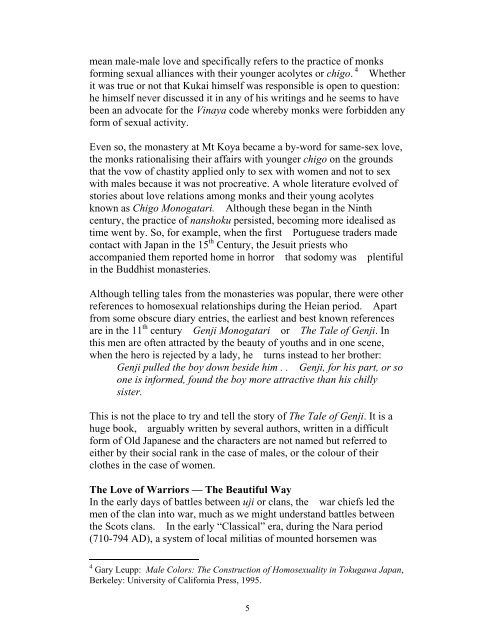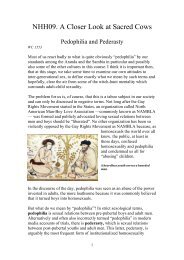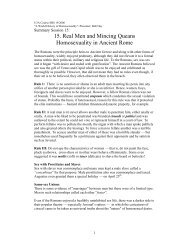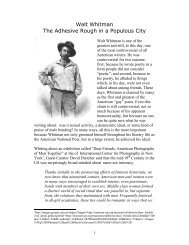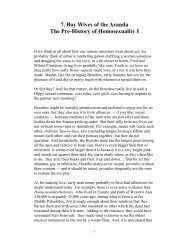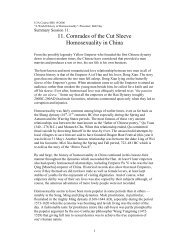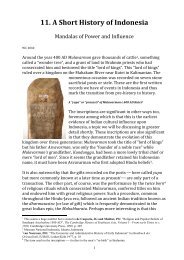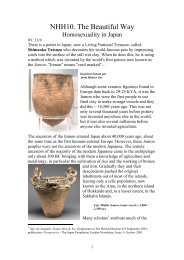10. The Beautiful Way Homosexuality in Japan
10. The Beautiful Way Homosexuality in Japan
10. The Beautiful Way Homosexuality in Japan
Create successful ePaper yourself
Turn your PDF publications into a flip-book with our unique Google optimized e-Paper software.
mean male-male love and specifically refers to the practice of monks<br />
form<strong>in</strong>g sexual alliances with their younger acolytes or chigo. 4 Whether<br />
it was true or not that Kukai himself was responsible is open to question:<br />
he himself never discussed it <strong>in</strong> any of his writ<strong>in</strong>gs and he seems to have<br />
been an advocate for the V<strong>in</strong>aya code whereby monks were forbidden any<br />
form of sexual activity.<br />
Even so, the monastery at Mt Koya became a by-word for same-sex love,<br />
the monks rationalis<strong>in</strong>g their affairs with younger chigo on the grounds<br />
that the vow of chastity applied only to sex with women and not to sex<br />
with males because it was not procreative. A whole literature evolved of<br />
stories about love relations among monks and their young acolytes<br />
known as Chigo Monogatari. Although these began <strong>in</strong> the N<strong>in</strong>th<br />
century, the practice of nanshoku persisted, becom<strong>in</strong>g more idealised as<br />
time went by. So, for example, when the first Portuguese traders made<br />
contact with <strong>Japan</strong> <strong>in</strong> the 15 th Century, the Jesuit priests who<br />
accompanied them reported home <strong>in</strong> horror that sodomy was plentiful<br />
<strong>in</strong> the Buddhist monasteries.<br />
Although tell<strong>in</strong>g tales from the monasteries was popular, there were other<br />
references to homosexual relationships dur<strong>in</strong>g the Heian period. Apart<br />
from some obscure diary entries, the earliest and best known references<br />
are <strong>in</strong> the 11 th century Genji Monogatari or <strong>The</strong> Tale of Genji. In<br />
this men are often attracted by the beauty of youths and <strong>in</strong> one scene,<br />
when the hero is rejected by a lady, he turns <strong>in</strong>stead to her brother:<br />
Genji pulled the boy down beside him . . Genji, for his part, or so<br />
one is <strong>in</strong>formed, found the boy more attractive than his chilly<br />
sister.<br />
This is not the place to try and tell the story of <strong>The</strong> Tale of Genji. It is a<br />
huge book, arguably written by several authors, written <strong>in</strong> a difficult<br />
form of Old <strong>Japan</strong>ese and the characters are not named but referred to<br />
either by their social rank <strong>in</strong> the case of males, or the colour of their<br />
clothes <strong>in</strong> the case of women.<br />
<strong>The</strong> Love of Warriors — <strong>The</strong> <strong>Beautiful</strong> <strong>Way</strong><br />
In the early days of battles between uji or clans, the war chiefs led the<br />
men of the clan <strong>in</strong>to war, much as we might understand battles between<br />
the Scots clans. In the early “Classical” era, dur<strong>in</strong>g the Nara period<br />
(710-794 AD), a system of local militias of mounted horsemen was<br />
4 Gary Leupp: Male Colors: <strong>The</strong> Construction of <strong>Homosexuality</strong> <strong>in</strong> Tokugawa <strong>Japan</strong>,<br />
Berkeley: University of California Press, 1995.<br />
5


